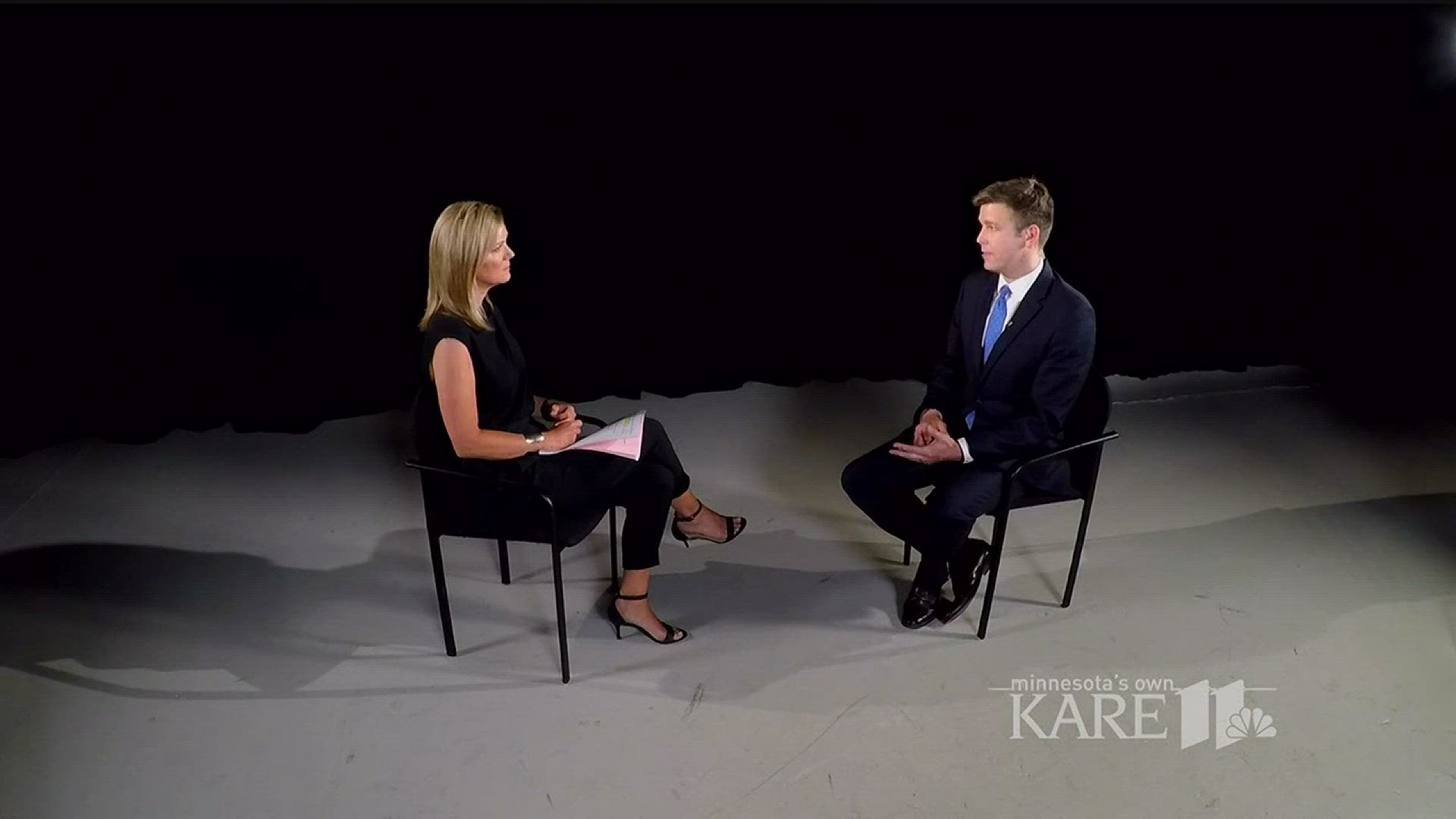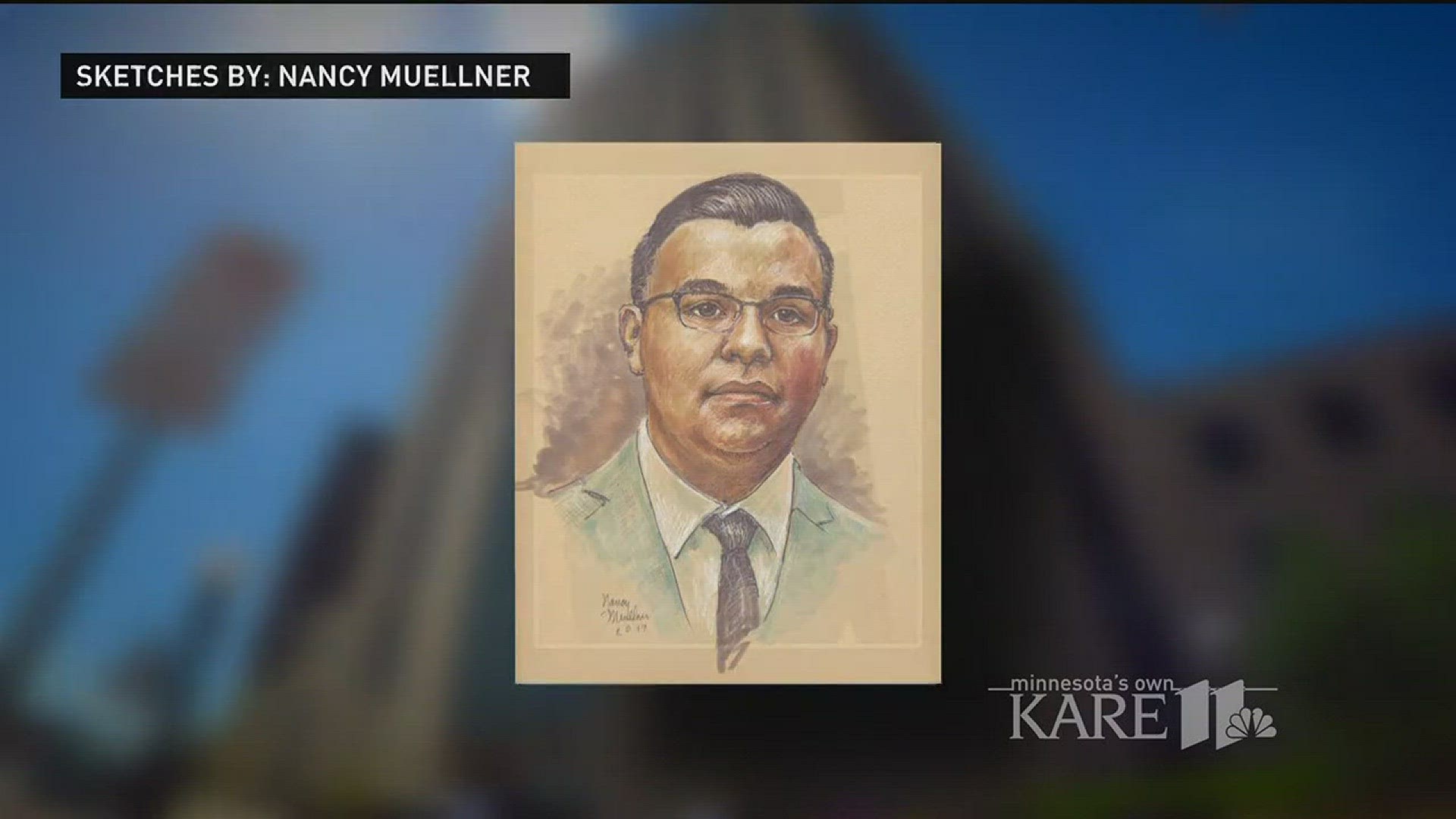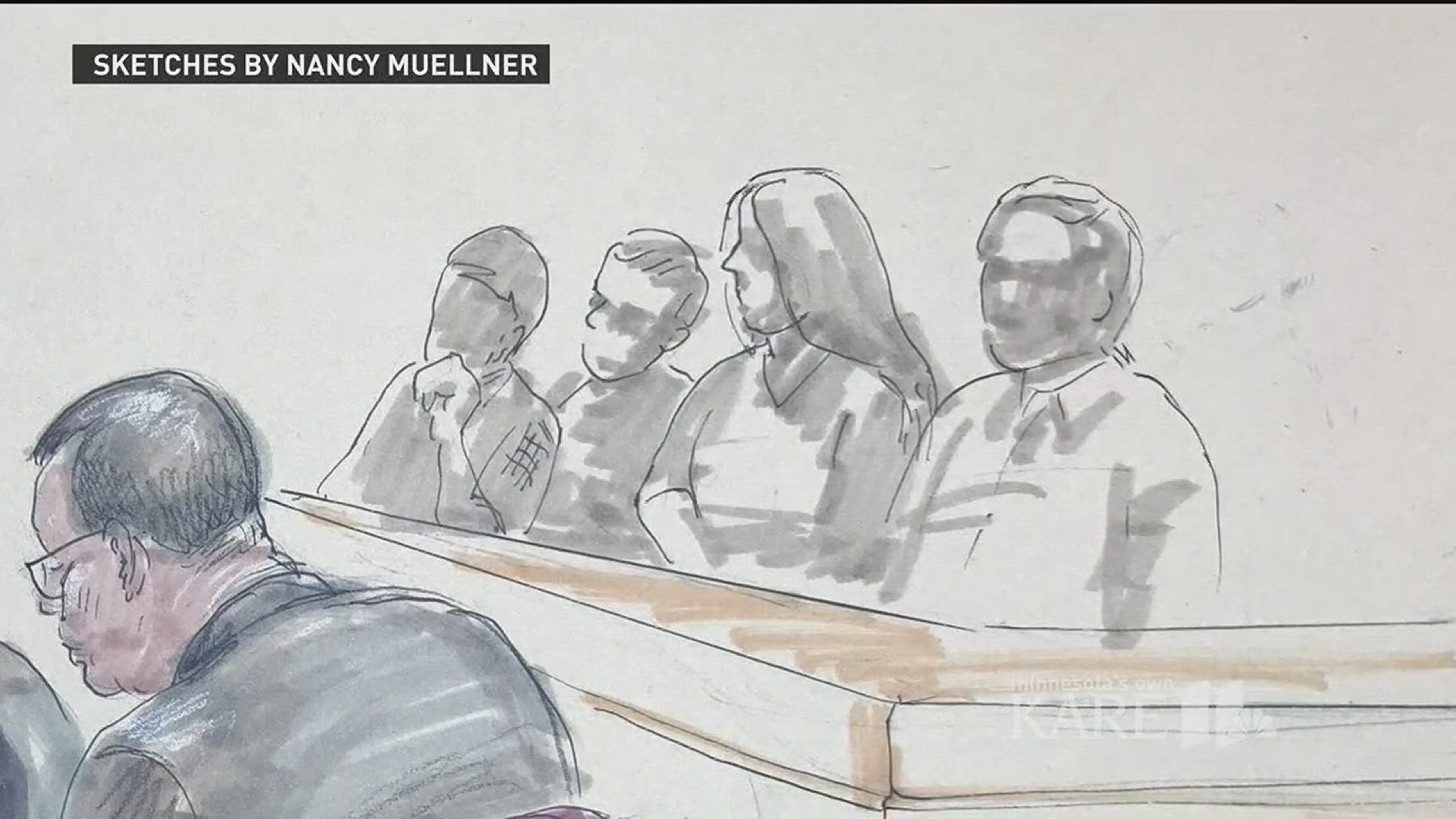ST. PAUL, Minn. - Officer Jeronimo Yanez sobbed as he took jurors back to the day he fatally shot Philando Castile.
This was the first time we've heard from Yanez, since he was charged with manslaughter in the 32-year-old's death last July.
"I was scared to death," he said on the stand. "I thought I was going to die. My family popped into my head. My wife. My baby girl."
Yanez's voice broke several times as he recounted the series of events on that fateful day -- a day he said he felt he had no other choice than to fire his weapon during that traffic stop.
"I was forced to engage Mr. Castile," he said. "I did not want to shoot Mr. Castile. Those were not my intentions."
Yanez told the jury the reasons why he stopped Castile on that July 6 night -- that his description fit that of a robbery suspect, an incident he responded to on July 2. Four days later, during roll call, Yanez said he and his fellow officers were reminded again to be on the lookout for possible suspects in that case, as none had been found.
He said as Castile drove by his squad car, he locked eyes with him and remembered him having a "deer in the headlights" look.
Castile was roughly the same age, same race and had similar dreadlocks to the robbery suspect, Yanez testified.
So he stopped the vehicle. He said when he approached Castile's car, he "was hit with the odor of burnt marijuana from within the vehicle."
He said Castile's left hand was on the steering wheel and his right hand was below it.
When he told Castile not to reach for his weapon, Yanez said, "I was able to see his right hand, it was in a C-shape. And he continued to pull out the firearm."
"He had total disregard for my commands," Yanez said.
During the cross examination, Yanez was questioned why he didn't tell the BCA investigators a description of Castile's gun but instead, told an officer who drove him home afterwards.
Yanez said he had nothing to hide during his interview with the BCA.
He said he reached into the car to try and stop Castile but felt the use of force was necessary, reasonable but ultimately tragic.
KARE 11's Lou Raguse said during Yanez's testimony, Castile's family looked on, completely composed. The jury listened to Yanez's testimony intently, not showing emotion.
Later Friday, the defense rested its case. Closing arguments are set for Monday. The 15-member jury could begin deliberations as early as Monday. The jury includes three alternates, but it's not clear who the alternates are. Two of the 15 are black.
Use of force experts
The location and visibility of Castile's gun is playing a prominent role in the testimony of expert witnesses.
Just where Castile had that gun, and whether or not it could be seen, could determine whether Yanez heads to prison or is set free. On Friday morning, the defense called Emanuel Kapelsohn, a nationally recognized expert on the use of force, to bolster their assertion that Yanez believed his life was in danger when he fired the shots that claimed Castile's life and is therefore not guilty of the charges.
In dramatic fashion, Kapelsohn held up a replica pair of the shorts Castile wore the night of his death and put a replica gun in the front pocket. He demonstrated to jurors how close to the top of the pocket the gun handle sits.
Kapelsohn testified that he did a similar experiment in April inside Castile's actual car and testified that the gun was within 1/8 of an inch from the pocket's opening even without pulling it out.
"If I separate the pocket, you can see in right there. I can reach in with a couple fingers and pull the gun out right now," Kapelsohn told the jury. "I don't need to stick my hand into the pocket."
While inside the vehicle Kapelsohn timed how quickly a 9 mm gun could be drawn from those shorts while sitting in the driver's seat, and he testified it took just 3/10 of a second on average.
KARE 11's Lou Raguse has been in the courtroom since the start of the trial, and says jurors could be seen taking detailed notes during Kapelsohn's testimony about his experiment. The use of force expert left no doubt about his take on the decision to use lethal force.
"It is my opinion Officer Yanez used reasonable force," Kapelsohn said. "He did what any other reasonable officer would do in the same situation."
Kapelsohn told jurors if they decide Yanez saw a gun, then he believed his life was in jeopardy and was justified in shooting.
On cross examination, the prosecution attempted to show the jury that Kapelsohn is nationally known for testifying in favor of officers, and only has one case in the last 28 months in which he is working for the prosecution in a criminal case against an officer.
About 100 people are packed into the courtroom Friday, including 40 family members, 24 reporters and eight attorneys.
THURSDAY
The defense team for St. Anthony Police officer Jeronimo Yanez on Thursday began building the case they hope will end with him being acquitted of manslaughter in the shooting death of Philando Castile.
A use-of-force expert testified that Yanez was right to use deadly force. Joseph Dutton testified Thursday for the defense. Dutton is convinced that Yanez saw a gun before he shot Castile during the traffic stop.
Prosecutors argue Yanez acted unreasonably in shooting Castile, and a prosecution expert Wednesday called the officer's actions "unreasonable" and "excessive." Yanez is charged with second degree manslaughter, which requires the state to prove he acted with "culpable negligence" by shooting Castile.
Confirmed Yanez will not be first witness tomorrow.. defense has a "couple" witnesses first. And closing arguments will likely be Monday
— Lou Raguse (@LouRaguse) June 8, 2017
Dutton was a police officer for 31 years and now teaches classes on the use of force. He says he reviewed videos and police reports. He says he's convinced by Yanez telling investigators he saw Castile's hand form a C-shaped grip of the sort that would be used to grab a thick gripped pistol.
Dutton said that's the type of detail a person wouldn't make up out of thin air. During cross examination prosecutors said a person could also may a C shape with a hand when releasing a seat belt buckle, but Dutton dismissed that idea.
Dutton also disputed the prosecution expert's opinion that Yanez should've positioned his body slightly behind Castile, aligned with the "B pillar" separating the front and back of the sedan.
As he was leaving the Ramsey County Courthouse, defense attorney Earl Gray said that Dutton's testimony "went splendidly" in the courtroom.
Defense toxicologist
A toxicology expert testified he believed Castile was under the influence of marijuana, at the time of his death.
Glenn Hardin, a former supervisor of Minnesota's state toxicology lab, testified Thursday as a witness for Yanez's defense.
Defense attorneys argued Castile was stoned at the time of the shooting, which happened in the seconds after he informed Yanez that he was carrying a gun. Hardin said he examined autopsy reports showing Castile's blood levels of THC, the substance in marijuana that gives a high.
Prosecutor Jeff Paulsen attacked Hardin's testimony by citing studies he said show there's no way to determine marijuana intoxication from blood samples, especially those taken after death.
Chief Jon Mangseth testifies
Earlier Thursday morning, Yanez's boss, St. Anthony Police Chief Jon Mangseth, was one of the first witnesses to be called to the stand. Mangseth told the courtroom that Yanez had no disciplinary problems or complaints on his record at the time of the fatal shooting last July, and said he had no reservations about Yanez's abilities as a police officer. The chief followed up by testifying that Yanez was selected for a special department program based on his willingness and ability to speak in public.
"So you were comfortable making him the face of your department?" the defense asked.
"One of the faces," Mangseth replied.
Defense Attorney Earl Gray says Officer Yanez will take the stand Friday afternoon.. He's pleased with expert witness testimony pic.twitter.com/8fLvxedHHa
— John Croman (@JohnCroman) June 8, 2017
Chief Mangseth went on to talk about the department's policies and training. When asked if there are situations that an officer cannot de-escalate, Mangseth said, "Yes, rapidly evolving situations." The defense then asked if it was OK for an officer to shoot at a suspect seven times, the chief said "Training dictates you shoot until the threat has been ceased. "
Under cross-examination by assistant prosecutor Jeff Paulsen, Mangseth discussed how he would handle a driver with a known firearm. Mangseth testified he told BCA he asks the driver to see his hands and put hands on steering wheel. The next step, according to the chief, is asking the suspect the location of the firearm. The prosecution emphasized this, tweeted KARE 11's Lou Raguse, to underline the fact Yanez did not follow what his chief describes as department protocol.
"Do you teach officers to shoot just because someone has a firearm?" Paulsen asked. "No," answered Mangseth. "Shoot just because a driver's hand goes out of sight for a second?" "No," said the chief.
In their redirect, a defense attorney asked Mangseth if the shooting would be permitted if an officer saw a suspect with his/her hand on a gun. The St. Anthony Chief offered a qualified answer, saying yes, based on the totality of the circumstances.
Three other witnesses were called Thursday morning, three police officers and a fire EMT who were on the scene in the wake of the shooting. Defense attorneys asked them questions about seeing or hearing a gun fall out of Castile's right front pocket.
During cross-examination, the prosecution got those officers to testify that when told by a driver about the presence of a gun, they ask to see that person's hands and ask the location of the gun. Yanez did neither.
Thursday began with the prosecution resting its case, calling no additional witnesses. The prosecution team did read a stipulation that both legal teams had agreed to, stating that Philando Castile was not involved in the SuperUSA robbery, and that had had a valid license, insurance, and no warrants out for his arrest.
At that point, the Yanez defense team moved for an acquittal, a motion that was quickly denied by Judge William Leary III.
Expert: Yanez had no reason to believe that Castile was a threat
On Wednesday an expert on police use of force told jurors that Yanez, who admits to fatally shooting Philando Castile, had no reason to believe that the man was a threat.
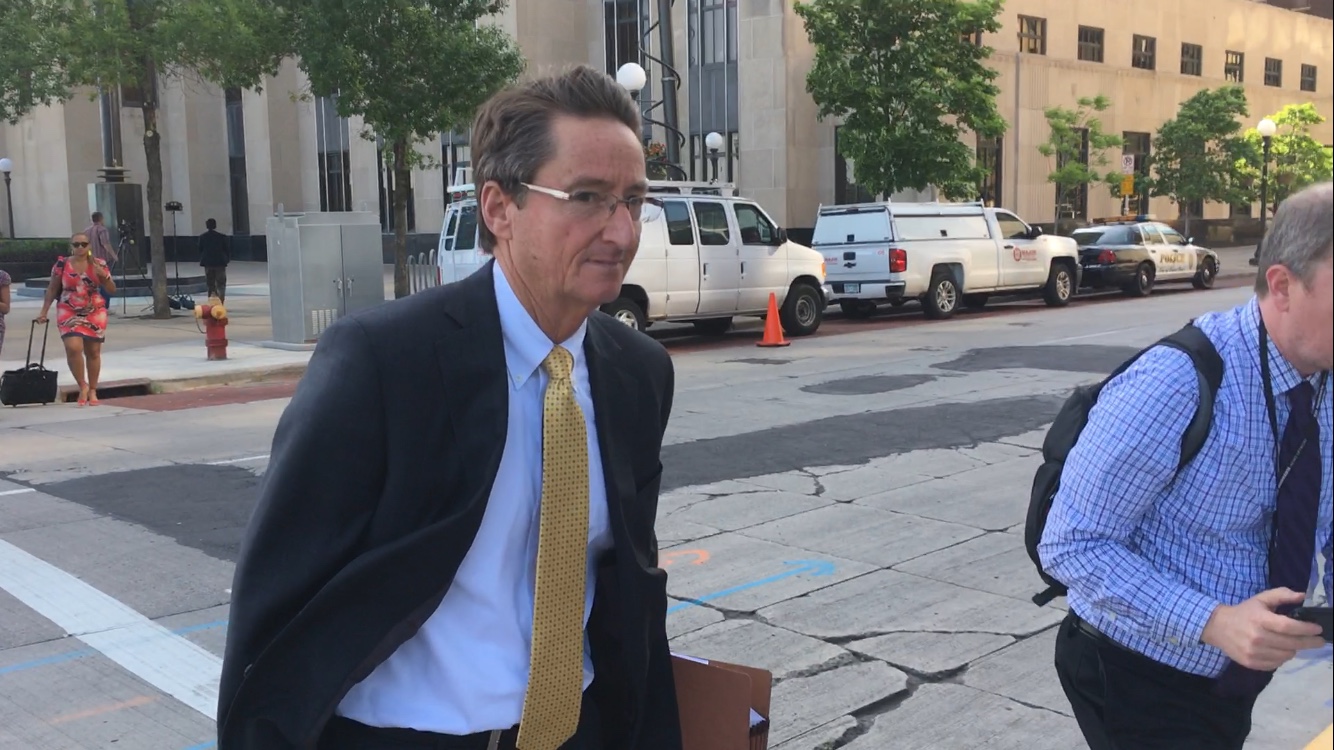
Jeffrey Noble testified Wednesday in the trial of Jeronimo Yanez. The St. Anthony police officer is charged with manslaughter in the death of Philando Castile. Yanez shot Castile after the motorist told him he was carrying a gun. Castile's girlfriend streamed the aftermath on Facebook.
"It is my opinion that Officer Yanez's use of force was objectively unreasonable. It was excessive and inappropriate," Noble said.
Under cross-examination, the defense pointed out Noble's opinion rests on the assumption Yanez did not see a gun in the car. Yanez plans to testify that he did.
Noble said, "It is my opinion that Yanez's use of force was objectively unreasonable. It was excessive and inappropriate."
— Lou Raguse (@LouRaguse) June 7, 2017
Prosecutors methodically went through the squad car video with Noble, pointing out each time Yanez failed to tell a fellow officer he saw a gun in the car.
"I would expect him to tell other officers there is a gun present and where the gun is at," Noble said.
Noble also testified that in his opinion, Yanez's orders to Castile were unclear, and that he should have ordered Castile to stop and put his hands on the steering wheel or dash.
When Castile volunteered he had a gun, Yanez replied, "Okay, don't pull it out then" and opened fire five seconds later because he thought Castile was making a move for the gun.
Noble said Yanez should've yelled "Put your hands up!" or "Freeze!" or "Stop!" if he thought he was in imminent danger.
On the dash cam video Castile can be heard saying,"I'm not pulling it out." Girlfriend Diamond Reynolds can be heard yelling, "He's not pulling it out!" Yanez then yells "Don't pull it out! Don't pull it out!" and begins firing.
Noble is a former deputy police chief in Irvine, California who once had to kill an armed bank robber early in his law enforcement career. He acknowledged no two critical incidents are the same, and that analyzing use of force is not a science.
But he said the US Supreme Court's ruling in Graham v. Connor lays out simple tests for what is reasonable use of force, including the severity of the suspect's crime, whether the suspect is fleeing, and whether the suspect poses an immediate threat to the officer's safety.
During cross examination Yanez's defense lawyer pointed out that in Minnesota the prosecution must prove "culpable negligence" to convict someone of second degree manslaughter.
Defense attorneys also asked whether being a suspect being impaired by marijuana could put an officer at increased risk, but Noble rejected the idea that Castile was impaired by that drug.
He said Castile made no mistakes while being followed for more than a mile by Yanez, and pulled over immediately when Yanez activated his light bar.
Castile autopsy
The official autopsy on Philando Castile showed he suffered two gunshot wounds to the heart during his encounter with Yanez, either of which would have been fatal.
Hennepin County Medical Examiner Dr. Andrew Baker performed the autopsy on Castile, and said he documented five wounds to Castile's left arm, four of which may have gone through and entered his chest.

Baker was followed by toxicology expert Dr. Kristen Engebretson, hired by the state to evaluate the levels of marijuana found in Castile's toxicology report. Engebretson testified that you cannot determine from THC test numbers exactly when the drug was smoked or ingested and added that those numbers are inaccurate when blood levels are tested after death. On cross-examination from the defense team, Engebretson did say that Castile's THC levels were high.
Expert: Castille's gun not ready to fire
During testimony Wednesday morning, a forensic expert told jurors that the gun carried by Castile was not ready to fire on the July evening he was fatally shot.
That finding was just part of the evidence shared by BCA forensic scientist Lindsey Garfield. Prosecutors showed the jury photos of the bullet holes in Castile's car that were fired by Yanez, one of them lodged into the center console and one that pierced the back seat, just 16 inches away from where the 4-year-old daughter of Castile's girlfriend, Diamond Reynolds, was sitting.
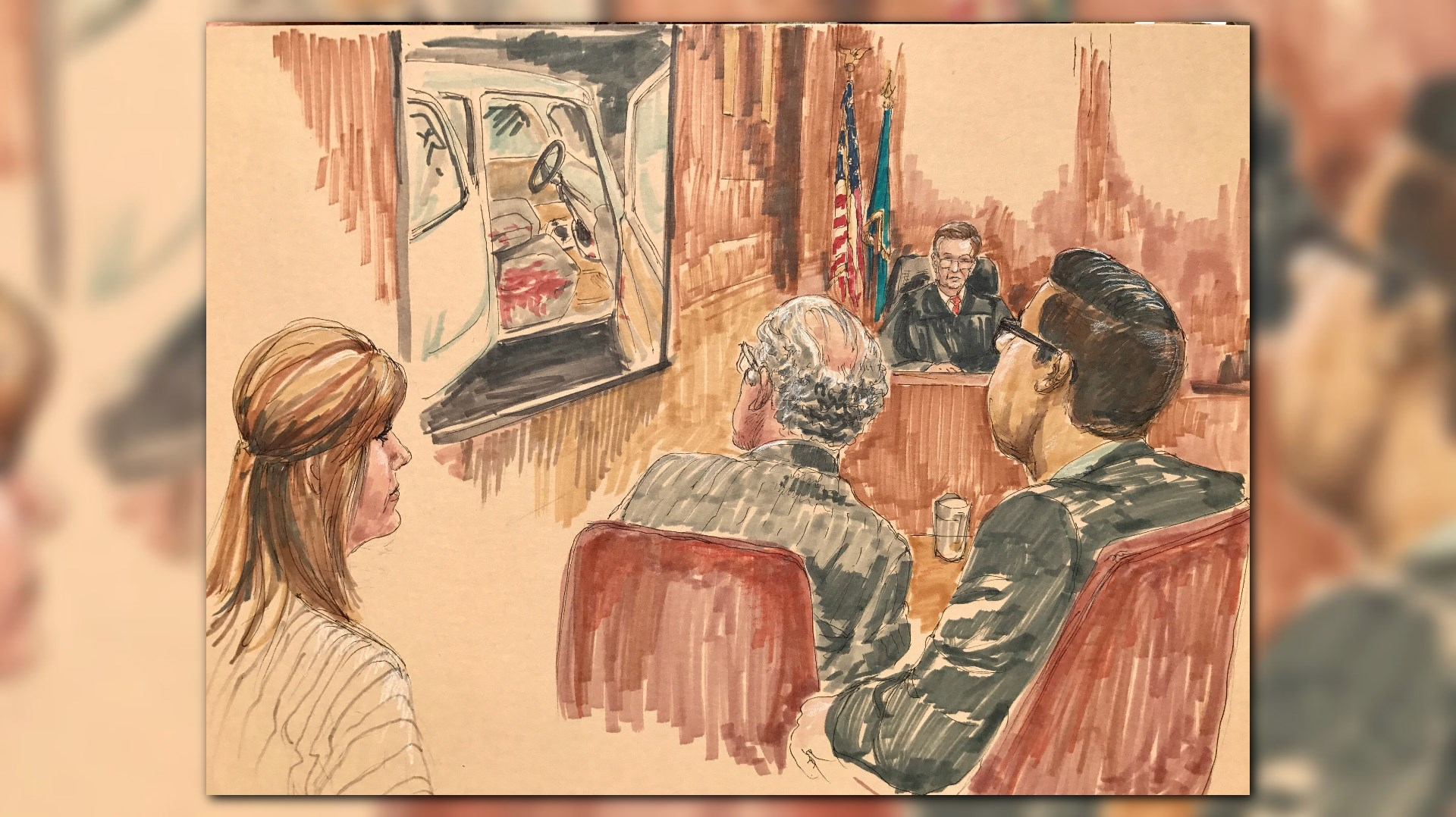
Garfield also testified that Castile's gun did not have a bullet in the chamber when examined by the BCA lab, and told jurors that the slide on the 9mm pistol would have to be pulled before the gun was ready to fire. On cross-examination, Yanez's defense team maintained that the officer would not know Castile's gun was not ready to fire simply by looking at it during the short and intense confrontation between the two.
The defense also showed the jury pictures of the car's ash tray, which was filled with cigarettes and loose tobacco. Yanez's lawyers pointed out blunts, or marijuana-mixed cigarettes, made by pulling out tobacco and adding pot to the cigarette. Garfield testified that the BCA did not test the ash tray contents for the presence of marijuana.
Garfield told the jury that the obvious stash of marijuana found inside Castile's car was tied inside a baggie that was sitting in a mason jar on the passenger seat. She said the lid to the mason jar was off. The defense used that piece of testimony to emphasize yet another inconsistency in the versions of events provided by Diamond Reynolds.
Officer Joseph Kauser sensed no danger
Tuesday was an important day in the courtroom as the police partner of Yanez told jurors he sensed no danger as he approached the traffic stop.
Officer Joseph Kauser took the stand during the latter part of Tuesday morning, to describe what he saw when he pulled up in a second squad car to help Yanez, who thought that the African-American man he had pulled over might be responsible for a recent armed robbery.
An audiotape was played for jurors during which Yanez described Castile's "wide-set nose," describing him as a potential suspect in a recent holdup of Super USA convenience store on Larpenteur Avenue.
When asked by assistant prosecutor Jeffrey Paulsen if, prior to the fatal shooting, he saw anything about the traffic stop that alarmed him, Kauser simply answered "no."
"Did you (prior to the shooting) feel threatened by what you saw?" Paulsen asked.
"At that point, I did not," the officer stated.

The jury watched, for the third time, the squad car video of the events that led to Yanez shooting Castile multiple times. Kauser was at the rear of the car, passenger side when Yanez opened fire. On the tape you can see that he is alarmed, jumping out of frame. When Kauser comes back into view, it is to help the 4-year-old daughter of Diamond Reynolds out of the squad car.
The squad car video also shows Yanez following the shooting, where he can be heard telling his supervising officer, "I don't know where the gun was."
Kauser said Yanez told him later that he saw Castile's gun.
"I think he followed protocol," Kauser said. "I trust him as a partner and I think he did what he was supposed to do in that situation."
During redirect from the prosecution, Kauser conceded he did not know what Castile was reaching for, when he saw him moving inside the car. And Kauser said he couldn't see a gun from his perspective, approaching on the passenger side of the car.
Prosecutors froze the dash cam video at various intervals to show that Castile's head pulled to the left as he reached for his proof of insurance to produce that, and then returned to center.
And the Ramsey County team replayed the dash cam video, highlighting a segment in which Yanez can be heard telling a supervisor "I don't know where the gun was" and "He wouldn't tell me where the gun was."
Yanez fired seven shots at Castile within 10 seconds of Castile informing him he had a firearm on his person.
Position of Castile's gun
Roseville Officer Juan Toran took the stand Tuesday to explain his role in the aftermath of the shooting. At one point he held Diamond Reynold's daughter Dae-ann, to make sure she didn't walk into traffic.
Officer Toran also ordered Reynolds to the ground and cuffed her, placing her in a squad car. He said he found her cell phone on the ground and returned it to her purse. Toran said he had met Yanez in 2014 when they took the Calibre Press seminar known as "Bulletproof Warriors," designed to prepare officers for life-or-death encounters.
He said other officers removed the wounded Castile from his seat, and placed him on the ground, and then Toran knelt beside Castile and began to do chest compressions in hopes of reviving him. Toran remained in that position for several minutes until St. Paul Fire Dept. EMTs arrived at the scene.
Toran said he was focused on the chest compressions at first, but when the EMT's started to turn Castile's body in order to move him onto a backboard stretcher he noticed a pistol start to slide out of Castile's right front pants pocket. Toran said he yelled, "Gun!" which is protocol, and then grabbed gun and eventually placed it on the ground.
The defense lawyers have contended that the pistol was close to the edge of the pocket, which is consistent with their contention that Officer Yanez could see the gun.
But St. Paul firefighter Eric Torgerson, who is also an EMT, said he saw an officer "reach deep into" Castile's right front pants pocket to retrieve the weapon. Torgerson was one of the first medics to arrive on the scene and cared for Castile in the ambulance on the trip to HCMC.
Torgerson said he saw no signs of life when he first saw Castile on the ground, and could not get any vital signs once he was in the ambulance. He said he was standing one foot away from Castile when the officer pulled the gun out of his pocket, and repeated that gun was deep in his pocket.
Lindsey Garfield, a crime scene coordinator for the Bureau of Criminal Apprehension, testified that Castile's 9 millimeter semi-automatic pistol had an ammo clip but there wasn't a bullet in the chamber. She said the gun was not ready to fire yet when Castile was killed, and it normally takes both hands to pull the slide and move a round into the chamber.
Diamond Reynolds takes the stand
Earlier, sitting before a packed, emotionally charged courtroom Tuesday, Philando Castile's girlfriend relived the day of his death, including the events before and after the fatal shooting at the hands of a St. Anthony police officer.
Diamond Reynolds began testifying Monday in the manslaughter case against Yanez. On Tuesday, proceedings began with a viewing of the squad car video of the fatal encounter, followed by the Facebook Live video shot by Reynolds in the wake of the shooting. Sniffles could be heard from the gallery, and one juror could be seen wiping tears throughout.
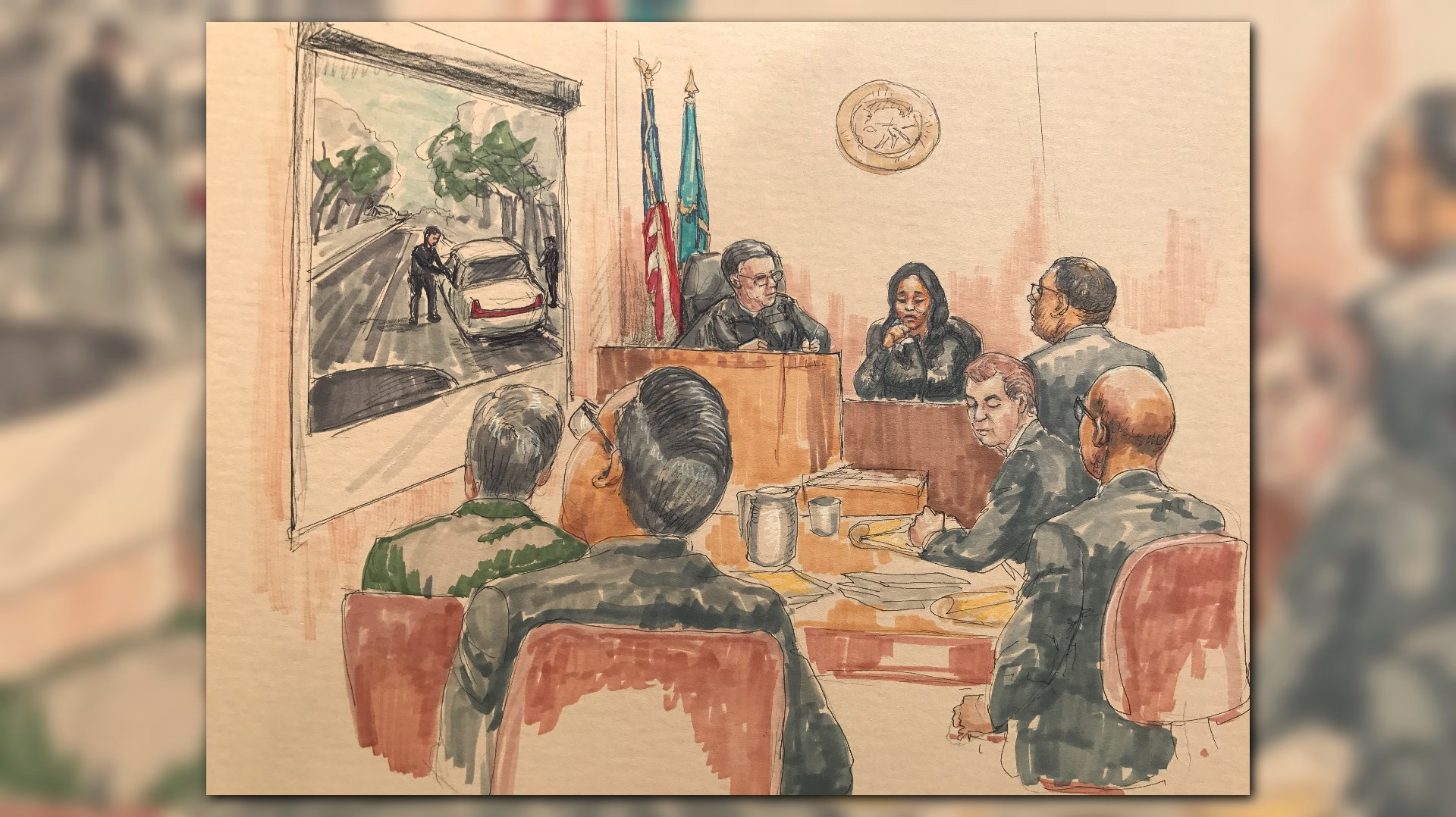
Prosecutor Clayton Robinson showed the jury three still photos pulled from the Facebook video to prove that Castile still had his seatbelt fastened when shot by Yanez.
Under direct examination, Robinson asked Reynolds, "Why did you make that video?"
She replied, "Because I know that the people are not protected by the police ... I wanted to make sure if I was to die in front of my daughter someone would know the truth."
Reynolds' 4-year-old daughter was in the car with the couple at the time of the fatal shooting.
Reynolds also recalled from the stand that Castile's last words to her were, "I can't breathe."
During cross-examination Yanez defense attorney Earl Gray pushed Reynolds on the couple's regular use of marijuana, forcing her to admit that she and Castile smoked pot nearly every day of their two-or-three-year relationship. She said they regularly bought marijuana, including the stash officers found in the car after the shooting. Reynolds insisted she didn't know there was pot in the car until Yanez pulled them over, and she felt the stash under her seat with the back of her foot.
Gray pushed hard to establish that Reynolds changed her story about exactly what Castile was reaching for when he was shot by Yanez. During an interview, the night of the shooting, Reynolds told investigators that Castile was reaching for his wallet as she said during the Facebook Live. But during a separate interview, in May of 2017 with prosecutors present, Reynolds apparently maintained he was reaching to unbuckle his seat belt.
In Monday's testimony, Reynolds began recounting what happened the day the 32-year-old Castile was shot. She said she saw Castile leave the apartment that morning with his gun in the holster -- something he always did. She described how Castile took care of her and her daughter and would get her daughter ready each morning.
Squad car video
The squad car video of the moments leading up to Castile's death were shown for the first time ever -- as opening statements in the manslaughter trial of Yanez began Monday.
After the final jury of nine men and six women were selected, state prosecutors began their opening statements by showing the video of the July 6, 2016 shooting -- the brief interaction of Castile and Yanez, before Castile's girlfriend began filming on Facebook Live.
In it, Yanez walks up to the vehicle and tells Castile he has a brake light that's out before asking for his license and insurance.
Castile hands over his insurance card and tells Yanez, "Sir, I do have to tell you I have a firearm," to which Yanez replies, "OK, don't reach for it then."
According to KARE 11 reporter Lou Raguse, the next few moments happen very quickly.
Castile attempts to tell the officer he's not reaching for it then Yanez says, "Don't pull it out," and a second later, shots are fired.
One thing that struck me is how visibly startled the other officer on the passenger side looked when the shots started. He jumped
— Lou Raguse (@LouRaguse) June 5, 2017
A total of seven shots are fired as Yanez stands next to the vehicle, gun pointed into the window and repeats, "don't move" several times.
Within seconds, Reynolds began her Facebook Live video.
In his opening statements, the prosecutor said Castile took two shots to the heart. He then emphasized Castile's final words, "I wasn't reaching for it."
"He didn't tell him to freeze," said Assistant Ramsey County Attorney Richard Dusterhoft. "He didn't tell him to put his hands up. It was Officer Yanez’s negligence from the traffic stop he chose to make that caused Mr. Castile's death."

The defense spent longer in their opening statements, stating though it happened quickly, "Castile's inability to follow commands is unfortunately timeless here."
They asked the jury to remember the line, "OK don't reach for it then," saying it shows Yanez believed Castile was reaching for his gun.
Defense Attorney Paul Engh said in his opening statement that Yanez didn't just believe Castile was reaching for his gun, but that he saw him begin to pull the gun out before he fired those seven shots into the car.
Diamond Reynolds took the witness stand on Monday. She described how Castile would get her daughter ready in the morning, and how he took care of them both.
She was just beginning to describe the events of July 6 when court recessed for the day. She will take the stand again on Tuesday.

Two people of color are seated on the jury, which was whittled down from 23 to 15 -- including an Ethiopian woman who the defense tried, unsuccessfully, to block.
Earlier in the day, the judge allowed evidence regarding Castile's legal permit to carry a handgun.
The decision was one of several announced in court.
While Judge William Leary III will allow prosecutors to inform jurors about Castile's legal carrying status, he will also allow defense attorneys to argue that Castile obtained it illegally because he lied about his drug use on the application.
On the issue of Castile's marijuana use, Leary decided that Yanez's team can show the jury there was pot in the car at the time of the shooting, and that he had THC present in his system. They cannot argue that he had smoked pot shortly before the fatal traffic stop and shooting.
Yanez plans to testify in his defense.

